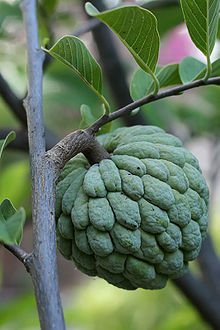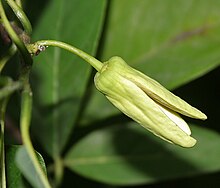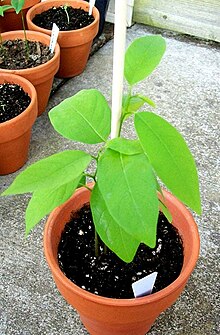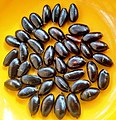Annona squamosae
Taxonomy not available for Annona; please create it automated assistant
| Àdàkọ:Speciesbox/hybrid name | |
|---|---|

| |

| |
| ' | |
| Ipò ìdasí | |
| Ìṣètò onísáyẹ́nsì [ edit ] | |
| Irú: | Template:Taxonomy/AnnonaA. squamosa
|
| Ìfúnlórúkọ méjì | |
| Template:Taxonomy/AnnonaAnnona squamosa | |
| Synonyms | |
|
Annona asiatica L.[3] | |
Annona squamosa jẹ́ igi kékeré tó ní ọ̀pọ̀lọpọ̀ ẹ̀ka láti ara ẹ̀yà Annonaceae tó ń so èso tó ṣe é jẹ tí wọ́n ń pè ní sugar apples tàbí sweetsops. Ó ní ìfẹ́ sí tropical lowland climate ju àwọn ìyókù rẹ̀Annona reticulata àti Annona cherimola (èyí tí èso wọn sábà máa ń ní orúkọ kan náà) èyí tó ṣe ìrànlọ́wọ́ tó sì sọ ọ́ di èso tí wọ́n ń gbìn jù láàárín àwọn ẹ̀yà yìí. Igi Annona squamosa jẹ́ igi kékeré pẹ̀lú ọ̀pọ̀lọpọ̀ ẹ̀ka tàbí igi kékeré pẹ̀lú ìwọ̀n mítà mẹ́ta sí mẹ́jọ (ìwọ̀n ẹsẹ̀ bàtà mẹ́wàá sí merindinlogbon) pẹ̀lú ìjọra sí soursop (Annona muricata). Ó jẹ́ ipa ọ̀nà òòrùn ojú ọjọ́ ìbílẹ̀ ní àwọn agbègbè America àti West Indies, àwọn olókòwò Spanish sì kó Manilla galleons ní Phillipines wá sí àgbègbè Asia.
Èso náà jẹ́ èyí tó ní ìrísí ródóródó, ó ní ìwọ̀n centimetre márùn-ún sí mẹ́wàá (ìwọ̀n méjì sí márùn-ún) ó sì gún ní ìwọ̀n centimetre mẹ́fà sí mẹ́wàá, ìwọ̀n bí ó ṣe wúwo sí jẹ́ ọgọ́rùn-ún sí òjìlénígba gíràmù. Àwọ̀ rẹ̀ dà bí àwọ̀ ewé pẹ̀lú àwọn àwọ̀ lóríṣiríṣi, èyí tó sì ní òdòdó. Ó dá yàtọ̀ láàárín àwọn èso Annona nígbà tí a bá ṣe àtúnpín ẹ̀; àwọn ìpín yìí ń ṣe Ìyàtọ̀ pípọ́n àti bí ó ṣe ń ṣàfihàn inú rẹ̀.
Awọ ara rẹ̀ rọ̀ ó sì dùn, funfun bí ìpara nípa àwọ̀ yẹ́lò tí kò jiná, tí ó sì dà bí custard lẹ́nu. Àwọn èso rẹ̀ wà nínú awọ, a rí i pé ó gùn tó ìwọ̀n mẹ́tàlá sí mẹ́rìndínlógún, èso tó dá dúró tí a ṣètò sí inú akọ̀ kan yípo ohun tó ṣe rodorodo. Ó rọ̀, kò kúnná tán, ó sì ń yọ̀. Irúgbìn líle tó ń dán náà máa ń tó ogún sí ogójì tàbí jù bẹ́ẹ̀ lọ nínú èso kan tí ó sì máa ń ní àwọ̀ dúdú tàbí jíjóná, bí ó tilẹ̀ jẹ́ pé ọ̀pọ̀ ti wà tó fẹ́rẹ̀ lè jẹ́ pé wọn ò ní irúgbìn. A lè lọ irúgbìn náà láti ṣe ogún tó ń pa kòkòrò. Gbòǹgbò rẹ̀ kọjá nínú ọ̀gangan inú èso náà èyí tó so ó pọ̀ mọ́ ìta. Awọ ara rẹ̀ sì dá bí Reuleaux Triangle tí ó ní àwọ̀ ewé tí kò sì dán lọ́wọ́. Nítorí awọ fẹ́lẹ́fẹ́lẹ́ tó ní àti bí sugar apple in náà ṣe rí, kò ṣe é mú gírígírí tó bá pọ́n tán.
Àwọn oríṣi mìíràn ni ó ti jẹyọ ní agbègbè Taiwan àti Hong Kong. Èso "atemoya tàbí pineapple sugar-apple", àtọwọ́dá láàárín sugar-apple àti cherimoya, jẹ́ gbajúgbajà ní agbègbè Taiwan, bí ó tilẹ̀ jẹ́ pé ìlú United States ni wọ́n ti kọ́kọ́ gbé e jáde ní ọdún 1908. Dídùn àwọn èso náà jọra pẹ̀lú sugar-apple, ṣùgbọ́n bí wọ́n ṣe rí lẹ́nu yàtọ̀ gédéńgbé. Gẹ́gẹ́ bí orúkọ rẹ̀ ti ṣe sọ, ó máa ń dùn bí pineapple.
Àpèjúwe[àtúnṣe | àtúnṣe àmìọ̀rọ̀]



Èso A. squamosa (sugar-apple) ní ara funfun tó dùn, ó sì jẹ́ gbajúgbajà ní àwọn ọjà àgbáyé.
Stems and leaves[àtúnṣe | àtúnṣe àmìọ̀rọ̀]

Branches with light brown bark and visible leaf scars; inner bark light yellow and slightly bitter; twigs become brown with light brown dots (lenticels – small, oval, rounded spots upon the stem or branch of a plant, from which the underlying tissues may protrude or roots may issue).[6]
Thin, simple, alternate leaves[7] occur singly,[6] 5 to 17 centimetres (2 to 6 3⁄4 inches) long and 2 to 6 cm (3⁄4 to 2 3⁄8 in) wide;[8][6] rounded at the base and pointed at the tip (oblong-lanceolate).[8] They are pale green on both surfaces and mostly hairless[6] with slight hairs on the underside when young.[9] The sides sometimes are slightly unequal and the leaf edges are without teeth, inconspicuously hairy when young.[6][7]
The leaf stalks are 0.4 to 2.2 cm (1⁄8 to 7⁄8 in) long,[8] green, and sparsely pubescent.[6]
Flowers[àtúnṣe | àtúnṣe àmìọ̀rọ̀]
Solitary or in short lateral clusters of 2–4 about 2.5 cm (1 in) long,[8] greenish-yellow flowers on a hairy, slender[6] 2 cm (3⁄4 in) long stalk.[8] Three green outer petals, purplish at the base, oblong, 1.6 to 2.5 cm (5⁄8 to 1 in) long, and 0.6 to 0.75 cm (1⁄4 to 5⁄16 in) wide, three inner petals reduced to minute scales or absent.[9][8] Very numerous stamens; crowded, white, less than 1.6 cm (5⁄8 in) long; ovary light green. Styles white, crowded on the raised axis. Each pistil forms a separate tubercle (small rounded wartlike protuberance), mostly 1.3 to 1.9 cm (1⁄2 to 3⁄4 in) long and 0.6 to 1.3 cm (1⁄4 to 1⁄2 in) wide which matures into the aggregate fruit.[6]
Flowering occurs in spring-early summer[8] and flowers are pollinated by nitidulid beetles.[10] Its pollen is shed as permanent tetrads.[11]
Fruits and reproduction[àtúnṣe | àtúnṣe àmìọ̀rọ̀]
Fruits ripen 3 to 4 months after flowering.[12]
Aggregate and soft fruits form from the numerous and loosely united pistils of a flower[6] which become enlarged[8] and mature into fruits which are distinct from fruits of other species of genus[6] (and more like a giant raspberry instead).
The round or heart-shaped[6] greenish yellow, ripened aggregate fruit is pendulous[8] on a thickened stalk; 5 to 10 cm (2 to 3 7⁄8 in)[6][9] in diameter[8][7] with many round protuberances[6] and covered with a powdery bloom. Fruits are formed of loosely cohering or almost free carpels (the ripened pistels).[9]
The pulp is white tinged yellow,[9] edible and sweetly aromatic. Each carpel containing an oblong, shiny and smooth,[6] dark brown[9] to black, 1.3 to 1.6 cm (1⁄2 to 5⁄8 in) long seed.[6]
Nutrition and uses[àtúnṣe | àtúnṣe àmìọ̀rọ̀]
Àdàkọ:Nutritional value Sugar-apple is high in energy, an excellent source of vitamin C and manganese, a good source of thiamine and vitamin B6, and provides vitamin B2, B3 B5, B9, iron, magnesium, phosphorus and potassium in fair quantities.[13]
Chemistry[àtúnṣe | àtúnṣe àmìọ̀rọ̀]
The diterpenoid alkaloid atisine is the most abundant alkaloid in the root. Other constituents of Annona squamosa include the alkaloids oxophoebine,[14] reticuline,[14] isocorydine,[15] and methylcorydaldine,[15] and the flavonoid quercetin-3-O-glucoside.[16]
Bayer AG has patented the extraction process and molecular identity of the annonaceous acetogenin annonin, as well as its use as a biopesticide.[17] Other acetogenins have been isolated from the seeds,[18] bark,[19] and leaves.[citation needed]
Distribution and habitat[àtúnṣe | àtúnṣe àmìọ̀rọ̀]
Annona squamosa is native to the tropical Americas and West Indies, but the exact origin is unknown. It is now the most widely cultivated of all the species of Annona, being grown for its fruit throughout the tropics and warmer subtropics, such as Indonesia, Thailand, Taiwan, and China as far north as Suzhou;[20] it was introduced to southern Asia before 1590. It is naturalized as far north as southern Florida in the United States and as south as Bahia in Brazil, Bangladesh, and is an invasive species in some areas.[6][21][7]
- Native
- Neotropic
- Caribbean: Antigua and Barbuda, Bahamas, Barbados, Cuba, Dominica, Dominican Republic, Grenada, Guadeloupe, Haiti, Jamaica, Martinique, Montserrat, Netherlands Antilles, Puerto Rico, St Kitts and Nevis, St Lucia, St Vincent and the Grenadines, Suriname, Trinidad and Tobago, Virgin Islands.
- Central America: Costa Rica, El Salvador, Guatemala, Honduras, Nicaragua, Panama
- Northern South America: Suriname, French Guiana, Guyana, Venezuela
- Western South America: Bolivia, Colombia, Ecuador, Peru
- Southern South America: Argentina, Brazil, Chile, Paraguay, Uruguay[6]
- Naturalised
-
- Pacific: Samoa, Tonga
- North America: Mexico, Belize
- Afrotropic: Angola, Sudan, Tanzania, Uganda, Zanzibar, Kenya
- Australasia: Australia, Fiji, New Zealand, Papua New Guinea, Solomon Islands
- Indomalaya: Bangladesh, Cambodia, China, India, Indonesia, Laos, Malaysia, Nepal, Pakistan, Philippines, Sri Lanka, Thailand, Vietnam
- Palearctic: Cyprus, Greece, Lebanon, Malta,[6] Israel
Climate and cultivation[àtúnṣe | àtúnṣe àmìọ̀rọ̀]
Àdàkọ:More citations needed section Like most species of Annona, it requires a tropical or subtropical climate with summer temperatures from 25 °C (77 °F) to 41 °C (106 °F), and mean winter temperatures above 15 °C (59 °F). It is sensitive to cold and frost, being defoliated below 10 °C (50 °F) and killed by temperatures of a couple of degrees below freezing. It is only moderately drought-tolerant, requiring at least 700 millimetres (28 in) of annual rainfall, and does not produce fruit well during droughts.
It will grow from sea level to an altitude of 2,000 metres (6,600 feet) and thrives in hot dry climates, differing in its tolerance of lowland tropics from many of the other fruit bearers in the Annona family.
It is quite a prolific bearer, and it produces fruit within as little as two to three years. A five-year-old tree can produce as many as 50 sugar apples. Poor fruit production has been reported in Florida because there are few natural pollinators (honeybees have a difficult time penetrating the tightly closed female flowers); however, hand pollination with a natural fibre brush is effective in increasing yield. Natural pollinators include beetles (coleoptera) of the families Nitidulidae, Staphylinidae, Chrysomelidae, Curculionidae and Scarabaeidae.[21][22]
Ecology[àtúnṣe | àtúnṣe àmìọ̀rọ̀]
In the Philippines, the fruit is commonly eaten by the Philippine fruit bat (kabag or kabog), which then spreads the seeds from island to island.
It is a host plant for larvae of the butterfly Graphium agamemnon (tailed jay).
Uses[àtúnṣe | àtúnṣe àmìọ̀rọ̀]
In traditional Indian, Thai, and Native American medicines, the leaves are boiled down with water, possibly mixed with other specific botanicals, and used in a decoction to treat dysentery and urinary tract infection.[23] In traditional Indian medicine, the leaves are also crushed for use as a poultice, and applied to wounds.[23] In Mexico, the leaves are rubbed on floors and put in hens' nests, to repel lice.[21] In Haiti, the fruit is known as cachiman and is used to simply make juice.[24] In Lebanon and Syria, it is made into a variety of desserts and sweets, referred to as ashta.[citation needed]
Àwòrán[àtúnṣe | àtúnṣe àmìọ̀rọ̀]
-
Annona squamosa fruit from Myanmar
-
Sugar apple (right), with Taiwanese "pineapple shijia" (atemoya) (left)
-
The sugar apple readily breaks open when ripe.
-
A deconstruction of a sugar apple shows a lobe of fruit and pulpy segments with seeds.
-
A sugar apple ready to eat
-
Sugar apple (Annona squamosa) seeds
-
Red sugar apples from Myanmar
-
Sugar apples in Taitung, Taiwan
-
Sugar apple tree in Philippines
-
Two sugar apples in Bangladesh
-
A sugar apple in tree in Terai of Nepal
Àwọn ìtọ́kasí[àtúnṣe | àtúnṣe àmìọ̀rọ̀]
- ↑ Àdàkọ:Cite iucn
- ↑ Natural Resources Conservation Service (NRCS). "PLANTS Profile, Annona squamosa L". The PLANTS Database. United States Department of Agriculture. Retrieved 2008-04-17.
- ↑ Àdàkọ:GRIN
- ↑ Dr. Richard Wunderlin, Dr. Bruce Hansen. "synonyms of Annona squamosa". Atlas of Florida Vascular Plants. Institute for Systematic Botany, University of Florida. Retrieved 2008-04-17.
- ↑ Missouri Botanical Garden (1753). "Annona squamosa L". Tropicos. Retrieved 2008-04-17.
- ↑ 6.00 6.01 6.02 6.03 6.04 6.05 6.06 6.07 6.08 6.09 6.10 6.11 6.12 6.13 6.14 6.15 6.16 6.17 6.18 "Current name: Annona squamosa". AgroForestryTree Database. International Center For Research In Agroforestry. Archived from the original on 2011-05-26. Retrieved 2008-04-17.
- ↑ 7.0 7.1 7.2 7.3 "Annona squamosa". Pacific Island Ecosystems at Risk (PIER). 2008-01-05. Archived from the original on 12 May 2008. Retrieved 2008-04-17. Unknown parameter
|url-status=ignored (help) - ↑ 8.00 8.01 8.02 8.03 8.04 8.05 8.06 8.07 8.08 8.09 Kral, Robert. "Annona squamosa Linnaeus, Sp. Pl. 1: 537. 1753". In Flora of North America Editorial Committee. Flora of North America North of Mexico. 3. http://beta.floranorthamerica.org/Annona_squamosa. Retrieved 2019-09-05.
- ↑ 9.0 9.1 9.2 9.3 9.4 9.5 "Compilation: Annona squamosa". Global Plants. JSTOR. Retrieved 2019-09-05.
- ↑ McGregor, S.E. Insect Pollination Of Cultivated Crop Plants Archived 2023-03-26 at the Wayback Machine. USDA, 1976
- ↑ Walker JW (1971) Pollen Morphology, Phytogeography, and Phylogeny of the Annonaceae. Contributions from the Gray Herbarium of Harvard University, 202: 1-130.
- ↑ Grant, Amy (2021). "What Is Sugar Apple Fruit: Can You Grow Sugar Apples". Gardening Know How. Retrieved 4 August 2023.
- ↑ "Benefits of Custard apple". 22 December 2014. https://www.youtube.com/watch?v=0QgdQYKGIpM.
- ↑ 14.0 14.1 Dholvitayakhun A, Trachoo N (2013). "Potential applications for Annona squamosa leaf extract in the treatment and prevention of foodborne bacterial disease". Natural Product Communications 8 (3): 385–388. doi:10.1177/1934578X1300800327. PMID 23678817.
- ↑ 15.0 15.1 Yadav DK, Singh N (2011). "Anti-ulcer constituents of Annona squamosa twigs". Fitoterapia 82 (4): 666–675. doi:10.1016/j.fitote.2011.02.005. PMID 21342663.
- ↑ Panda S, Kar A (2007). "Antidiabetic and antioxidative effects of Annona squamosa leaves are possibly mediated through quercetin-3-O-glucoside". BioFactors 31 (3–4): 201–210. doi:10.1002/biof.5520310307. PMID 18997283.
- ↑ Moeschler HF, Pfluger W; et al. (August 1987). "Insecticide US 4689232 A". Retrieved 2014-12-03.
- ↑ Chen Y, Xu SS (2012). "Anti-tumor activity of Annona squamosa seeds extract containing annonaceous acetogenin compounds". Journal of Ethnopharmacology 142 (2): 462–466. doi:10.1016/j.jep.2012.05.019. PMID 22609808.
- ↑ Li XH, Hui YH (1990). "Bullatacin, bullatacinone, and squamone, a new bioactive acetogenin, from the bark of Annona squamosa". Journal of Natural Products 53 (1): 81–86. doi:10.1021/np50067a010. PMID 2348205.
- ↑ "Sweetsop (Annona squamosa)". January 2020.
- ↑ 21.0 21.1 21.2 Morton, Julia (1987). "Sugar Apple Annona squamosa". Fruits of warm climates. Department of Horticulture & Landscape Architecture, Purdue University. p. 69. Archived from the original on 5 April 2008. Retrieved 2008-04-17. Unknown parameter
|url-status=ignored (help) - ↑ "Annona squamosa". AgroForestryTree Database. Archived from the original on 14 March 2007. Retrieved 16 September 2013. Unknown parameter
|url-status=ignored (help) - ↑ 23.0 23.1 Dholvitayakhun A, Trachoo N (2016). "Using scanning and transmission electron microscopy to investigate the antibacterial mechanism of action of the medicinal plant Annona squamosa Linn". Journal of Herbal Medicine 7: 31–36. doi:10.1016/j.hermed.2016.10.003. https://zenodo.org/record/884833.
- ↑ "Cachiman (Annona reticulata L.)". Carib Fruits. Retrieved 8 November 2020.
- Pages with citations using unsupported parameters
- Pages containing cite templates with deprecated parameters
- Webarchive template wayback links
- IUCN Red List least concern species
- Automatic taxobox cleanup
- Taxoboxes with no color
- All articles with unsourced statements
- Articles with unsourced statements from December 2019
- Articles with invalid date parameter in template
- Articles with unsourced statements from February 2021
- Taxonbars desynced from Wikidata
- Taxonbar pages requiring a Wikidata item
- Taxonbars with 25–29 taxon IDs













